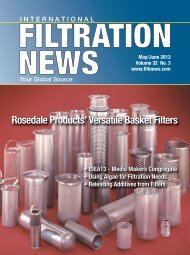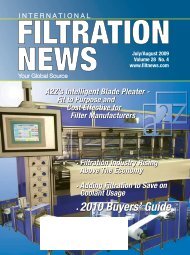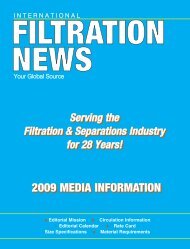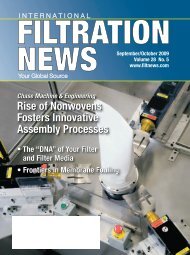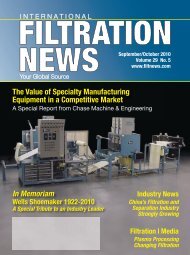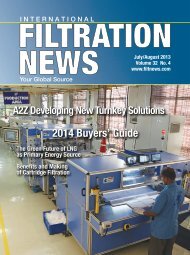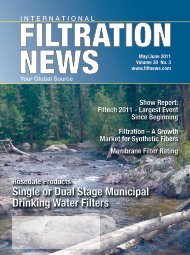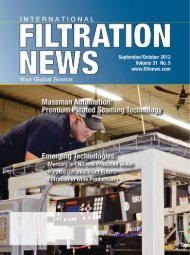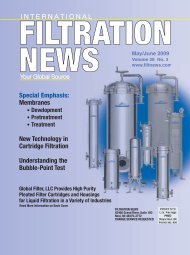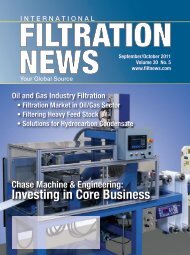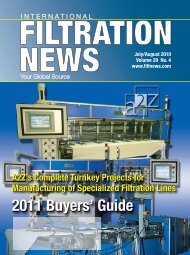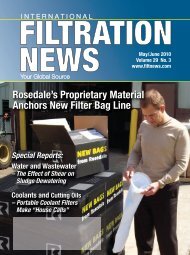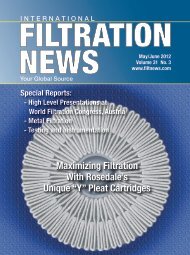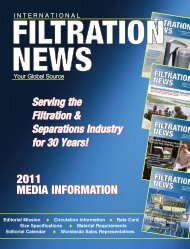2013 Buyers' Guide 2013 Buyers' Guide - Filtration News
2013 Buyers' Guide 2013 Buyers' Guide - Filtration News
2013 Buyers' Guide 2013 Buyers' Guide - Filtration News
You also want an ePaper? Increase the reach of your titles
YUMPU automatically turns print PDFs into web optimized ePapers that Google loves.
Absorbents | Adsorbents<br />
Removing Water from Petroleum<br />
with Super Absorbent Polymers<br />
By Erin L. Johnson, Gelok International<br />
F<br />
or years, society has<br />
been taught the benefits<br />
of water to support<br />
life and to sustain<br />
processes. However, for any<br />
number of industries that depend<br />
on the consumption<br />
and use of hydrocarbon fluids,<br />
water is an ever-present<br />
nemesis. But why is controlling<br />
water such an essential<br />
consideration According to a<br />
Machinery Lubrication news<br />
article by Martin Williamson,<br />
the evil effects of water are<br />
many.<br />
Water can:<br />
•Cause contamination of<br />
the oil’s base stock, encouraging<br />
oxidation, viscosity increase<br />
and foaming<br />
•Affect the additive package through<br />
water washing and hydrolysis,<br />
leading to acids and additive<br />
depletion<br />
•Encourage rust and corrosion<br />
•Cause increased wear as a result of<br />
aeration, changes in viscosity<br />
resulting in film strength failure,<br />
hydrogen blistering and<br />
embrittlement, and vaporous<br />
cavitation<br />
•Generate other contaminants in the<br />
oil such as waxes, suspensions,<br />
carbon and oxide insolubles and<br />
even micro-organisms<br />
Mr. Williamson suggests that systemic<br />
water contamination control is<br />
available utilizing one or several of the<br />
following five separation techniques<br />
shown in Table 1.<br />
Consequently, a series of innovative<br />
adjacent markets and manufactures have<br />
taken action to create products that mitigate<br />
the presence of water in hydrocarbon<br />
fluids. Gelok International<br />
Corporation is one such player. Since the<br />
mid 1980’s, the company has been a premier<br />
manufacturer of thin, low-dusting,<br />
super absorbent laminates and composites<br />
suitable for the polymer absorption<br />
technique specified in the table above.<br />
Their custom designs contain super absorbent<br />
polymers, which have been impregnated<br />
between layers of cellulosic<br />
substrate resulting in an absorbent, roll<br />
good media:<br />
Gelok’s roll<br />
products are<br />
ultra-thin and<br />
easily introduced<br />
into conv<br />
e n t i o n a l<br />
spin-on or cartridge<br />
type filters<br />
via co-pleating<br />
with other filtration<br />
media.<br />
Gelok laminate<br />
The<br />
20 • August 2012 • www.filtnews.com<br />
Table 1<br />
benefits of using Gelok laminates include:<br />
• Extraordinarily thin profile<br />
• Customizable substrate selections<br />
• Customizable SAP loading values<br />
• Wide absorbency performance<br />
range (100-1500 g/sq ft)<br />
• Light weight input resulting in a<br />
compact end product<br />
• Provide excellent wicking direct<br />
to core<br />
• Consistent finished product profile<br />
• Easy-to-use commercial roll good form<br />
• Low start-up costs



